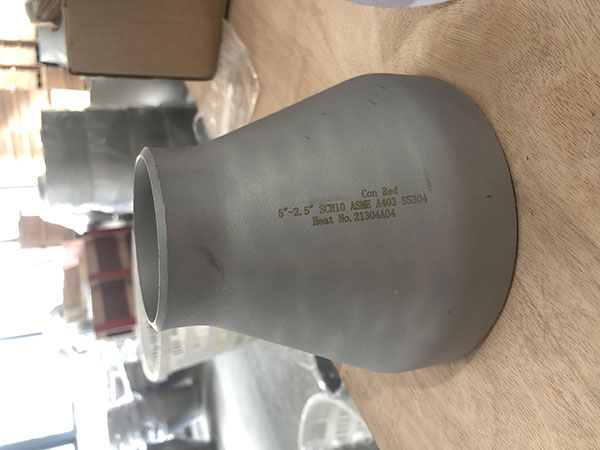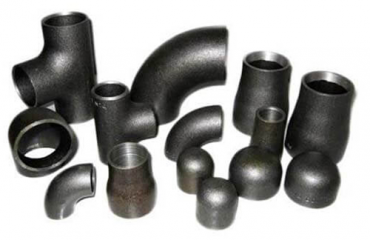
ลดสแตนเลส: เกรด ASTM A403 WP
แนะนำ
ตัวลดขนาดสเตนเลสเป็นส่วนประกอบสำคัญในระบบท่อ, ออกแบบมาเพื่อเชื่อมต่อท่อที่มีเส้นผ่านศูนย์กลางต่างกันในขณะที่ยังคงการไหลของของเหลวหรือก๊าซได้อย่างราบรื่น. พวกเขามาในสองประเภทหลัก: Reducers ศูนย์กลาง, ซึ่งมีเส้นกลางร่วมกัน, และตัวลดประหลาด, ซึ่งมีเส้นกึ่งกลางออฟเซ็ต. เอกสารนี้ให้ข้อมูลเบื้องต้นโดยละเอียดและการวิเคราะห์เชิงลึกของตัวลดขนาดสเตนเลส, โดยเฉพาะที่สอดคล้องกับเกรด ASTM A403 WP, รวมทั้ง 304, 304ชม, 309, 310, 316, 316L, 317L, 321, 347, และ 904L.
ภาพรวมเกรด ASTM A403 WP
ASTM A403 WP304 และ WP304H
- WP304: มาตรฐาน 18/8 เหล็กกล้าไร้สนิม (18% โครเมียม, 8% นิกเกิล) เป็นที่รู้จักในด้านความต้านทานการกัดกร่อนและการขึ้นรูปที่ดีเยี่ยม.
- WP304H: WP304 รุ่นคาร์บอนสูง, ให้ความแข็งแรงที่อุณหภูมิสูงได้ดีขึ้น.
ASTM A403 WP309
- มีโครเมียมสูง, เหล็กกล้าไร้สนิมนิกเกิลสูงให้ความต้านทานต่อการเกิดออกซิเดชันและความแข็งแรงที่เหนือกว่าที่อุณหภูมิสูง.
ASTM A403 WP310
- เป็นที่รู้จักในด้านความทนทานต่ออุณหภูมิสูงและการกัดกร่อน, WP310 เหมาะอย่างยิ่งสำหรับการใช้งานบริการที่อุณหภูมิสูง.
ASTM A403 WP316 และ WP316L
- WP316: เสริมด้วยโมลิบดีนัมเพื่อความทนทานต่อการกัดกร่อนได้ดีขึ้น, โดยเฉพาะกับคลอไรด์และตัวทำละลายทางอุตสาหกรรมอื่นๆ.
- WP316L: WP316 รุ่นคาร์บอนต่ำ, ให้ความสามารถในการเชื่อมที่ดีเยี่ยมและลดความเสี่ยงของการตกตะกอนของคาร์ไบด์ระหว่างการเชื่อม.
ASTM A403 WP317L
- คล้ายกับ WP316 แต่มีปริมาณโมลิบดีนัมสูงกว่า, ให้ความต้านทานที่เหนือกว่าต่อการกัดกร่อนแบบรูพรุนและรอยแยก.
ASTM A403 WP321
- สเตนเลสสตีลออสเตนิติกเสถียรด้วยไทเทเนียม ให้ความต้านทานต่อการกัดกร่อนตามขอบเกรนได้อย่างดีเยี่ยม หลังจากการสัมผัสกับอุณหภูมิในช่วงการตกตะกอนของโครเมียมคาร์ไบด์.
ASTM A403 WP347
- สเตนเลสสตีลเสถียรโคลัมเบียมมีความทนทานต่อการกัดกร่อนตามขอบเกรนได้ดีเยี่ยม, เหมาะสำหรับงานที่มีอุณหภูมิสูง.
ASTM A403 WP904L
- สเตนเลสออสเทนนิติกอัลลอยด์สูงที่มีความทนทานต่อการกัดกร่อนดีเยี่ยม, โดยเฉพาะกับกรดซัลฟิวริก, และปรับปรุงคุณสมบัติทางกล.
บทนำโดยละเอียด
องค์ประกอบและคุณสมบัติ
| เกรด | Cr (%) | Ni (%) | Mo (%) | องค์ประกอบอื่นๆ | คุณสมบัติที่สำคัญ |
|---|---|---|---|---|---|
| WP304 | 18-20 | 8-10.5 | – | – | ความต้านทานการกัดกร่อน, ความสามารถในการขึ้นรูป |
| WP304H | 18-20 | 8-10.5 | – | ไฮซี | ความแข็งแรงที่อุณหภูมิสูง |
| WP309 | 22-24 | 12-15 | – | – | ต้านทานการเกิดออกซิเดชัน, มีความแข็งแรงสูง |
| WP310 | 24-26 | 19-22 | – | – | ความยืดหยุ่นที่อุณหภูมิสูง |
| WP316 | 16-18 | 10-14 | 2-3 | – | ความต้านทานต่อคลอไรด์, ความทนทาน |
| WP316L | 16-18 | 10-14 | 2-3 | ซีต่ำ | ความสามารถในการเชื่อม, ความต้านทานการกัดกร่อน |
| WP317L | 18-20 | 11-15 | 3-4 | ซีต่ำ | ความต้านทานการกัดกร่อนแบบรูพรุนและรอยแยก |
| WP321 | 17-19 | 9-12 | – | Ti | ความต้านทานการกัดกร่อนตามขอบเกรน |
| WP347 | 17-19 | 9-12 | – | Nb | ความต้านทานการกัดกร่อนตามขอบเกรน |
| WP904L | 19-23 | 23-28 | 4-5 | Cu, Mn, ศรี | ความต้านทานต่อกรดซัลฟิวริก, ความเหนียว |
คุณสมบัติทางกล
| เกรด | ความแข็งแรง (MPa) | ความแข็งแรงให้ผลผลิต (MPa) | ยืดตัว (%) | ความแข็ง (HB) |
|---|---|---|---|---|
| WP304 | 515 | 205 | 40 | 201 |
| WP304H | 515 | 205 | 40 | 201 |
| WP309 | 620 | 310 | 30 | 220 |
| WP310 | 620 | 310 | 30 | 220 |
| WP316 | 515 | 205 | 40 | 217 |
| WP316L | 485 | 170 | 40 | 217 |
| WP317L | 515 | 205 | 40 | 217 |
| WP321 | 515 | 205 | 40 | 217 |
| WP347 | 515 | 205 | 40 | 201 |
| WP904L | 490 | 220 | 35 | 192 |
การวิเคราะห์เชิงลึก
ความต้านทานการกัดกร่อน
- WP304 และ WP304H: ต้านทานได้ดีเยี่ยมต่อสภาพแวดล้อมในชั้นบรรยากาศที่หลากหลายและตัวกลางที่มีฤทธิ์กัดกร่อนหลายชนิด.
- WP309 และ WP310: ต้านทานการเกิดออกซิเดชันที่เหนือกว่า, เหมาะสำหรับสภาพแวดล้อมที่มีอุณหภูมิสูง.
- WP316 และ WP316L: เพิ่มความต้านทานต่อคลอไรด์และตัวทำละลายในอุตสาหกรรม, ทำให้เหมาะสำหรับสภาพแวดล้อมทางทะเลและทางเคมี.
- WP317L: ให้ความต้านทานต่อการกัดกร่อนแบบรูพรุนและรอยแยกได้ดีกว่า WP316.
- WP321 และ WP347: ทั้งสองเกรดต้านทานการกัดกร่อนตามขอบเกรน, ด้วย WP321 ทำให้เสถียรโดยไทเทเนียม และ WP347 โดยโคลัมเบียม.
- WP904L: ให้ความต้านทานเป็นพิเศษต่อกรดซัลฟิวริกและสภาพแวดล้อมที่มีฤทธิ์กัดกร่อนสูงอื่นๆ.
ประสิทธิภาพการทำงานที่อุณหภูมิสูง
- WP304H, WP309, WP310: เกรดเหล่านี้ได้รับการออกแบบมาโดยเฉพาะสำหรับการใช้งานที่อุณหภูมิสูง, ด้วย WP304H ที่ให้ความแข็งแกร่งที่อุณหภูมิสูงที่ดีขึ้นเนื่องจากมีปริมาณคาร์บอนสูงขึ้น.
- WP321 และ WP347: ทั้งสองเกรดทำงานได้ดีที่อุณหภูมิสูง, มีองค์ประกอบเสถียรภาพช่วยป้องกันการตกตะกอนของคาร์ไบด์.
ความสามารถในการเชื่อมและการแปรรูป
- ซีรี่ส์ WP304 และ WP316: ความสามารถในการเชื่อมและการขึ้นรูปที่ดีเยี่ยม, เหมาะสำหรับการใช้งานที่หลากหลาย.
- WP316L และ WP317L: รุ่นคาร์บอนต่ำมีความสามารถในการเชื่อมที่เหนือกว่าโดยลดความเสี่ยงของการตกตะกอนของคาร์ไบด์.
- WP321 และ WP347: เกรดที่มีความเสถียรป้องกันการกัดกร่อนตามขอบเกรนหลังการเชื่อม, ทำให้เหมาะสมกับอุณหภูมิที่สูง, การใช้งานแบบเชื่อม.
- WP904L: แม้ว่าการเชื่อมจะมีความท้าทายมากขึ้นเนื่องจากมีปริมาณโลหะผสมสูง, สามารถเชื่อมได้สำเร็จโดยใช้เทคนิคที่เหมาะสม.
การใช้งาน
- WP304 และ WP304H: นิยมใช้ในการแปรรูปอาหาร, สารเคมี, และอุตสาหกรรมปิโตรเคมี.
- WP309 และ WP310: เหมาะสำหรับชิ้นส่วนเตาหลอม, แลกเปลี่ยนความร้อน, และการใช้งานที่อุณหภูมิสูงอื่นๆ.
- WP316 และ WP316L: ใช้กันอย่างแพร่หลายในสภาพแวดล้อมทางทะเล, กระบวนการทางเคมี, และอุปกรณ์ทางเภสัชกรรม.
- WP317L: เหมาะสำหรับกระบวนการแปรรูปทางเคมีและอุตสาหกรรมปิโตรเคมีที่ต้องการความต้านทานการกัดกร่อนที่สูงขึ้น.
- WP321 และ WP347: ใช้ในการแปรรูปเคมีและปิโตรเคมีที่อุณหภูมิสูง, การผลิตไฟฟ้า, และการใช้งานด้านการบินและอวกาศ.
- WP904L: พบในกระบวนการแปรรูปทางเคมี, โดยเฉพาะอย่างยิ่งเมื่อมีกรดซัลฟิวริกอยู่, เช่นเดียวกับในอุปกรณ์ระบายความร้อนน้ำทะเลและส่วนประกอบโรงกลั่นน้ำมัน.
กระบวนการผลิต
การขึ้นรูปและการขึ้นรูป
-
การขึ้นรูปร้อน: เกี่ยวข้องกับการทำความร้อนวัสดุที่อุณหภูมิสูง จากนั้นขึ้นรูปโดยใช้เครื่องอัดหรือลูกกลิ้ง. กระบวนการนี้ช่วยเพิ่มความเหนียวของวัสดุและลดความเสี่ยงของการแตกร้าว.
-
การขึ้นรูปเย็น: ดำเนินการที่อุณหภูมิห้อง, ให้พื้นผิวที่ดีขึ้นและความแม่นยำของมิติ. ยังไงก็ตา, ต้องใช้แรงมากขึ้นและอาจทำให้งานแข็งตัวได้.
เชื่อม
-
ทีไอจี (ก๊าซเฉื่อยทังสเตน) เชื่อม: ให้สูง-คุณภาพ เชื่อมด้วยการควบคุมความร้อนเข้าที่ดีเยี่ยม, เหมาะสำหรับส่วนประกอบที่มีผนังบาง.
-
ฉัน (ก๊าซเฉื่อยของโลหะ) เชื่อม: เร็วกว่าการเชื่อม TIG, เหมาะสำหรับวัสดุที่มีความหนาและสภาพแวดล้อมการผลิต.
การรักษาความร้อน
- การหลอมสารละลาย: เกี่ยวข้องกับการทำความร้อนวัสดุที่อุณหภูมิสูง จากนั้นทำให้เย็นลงอย่างรวดเร็วเพื่อละลายคาร์ไบด์ที่ตกตะกอน, คืนความต้านทานการกัดกร่อน.
การรักษาพื้นผิว
- การดองและการทู่: ขจัดสิ่งปนเปื้อนบนพื้นผิวและเพิ่มชั้นออกไซด์ป้องกันตามธรรมชาติของสแตนเลส, ปรับปรุงความต้านทานการกัดกร่อน.
ควบคุมคุณภาพ
-
การทดสอบแบบไม่ทำลาย (NDT): เทคนิคเช่นการถ่ายภาพรังสี, อัลตราโซนิก, และการทดสอบสารแทรกซึมของสีย้อมช่วยให้มั่นใจในความสมบูรณ์และ คุณภาพ ของรอยเชื่อมและวัสดุ.
-
ตรวจสอบมิติ: ตรวจสอบให้แน่ใจว่าตัวลดตรงตามข้อกำหนดและความคลาดเคลื่อนที่ต้องการ.
แนวโน้มตลาด
ไดรเวอร์ความต้องการ
- การพัฒนาโครงสร้างพื้นฐาน: การลงทุนที่เพิ่มขึ้นในโครงการโครงสร้างพื้นฐานทั่วโลกผลักดันความต้องการระบบท่อที่เชื่อถือได้.
- อุตสาหกรรมน้ำมันและก๊าซ: กิจกรรมการสำรวจและการผลิตที่กำลังดำเนินอยู่จำเป็นต้องใช้วัสดุประสิทธิภาพสูงที่สามารถทนต่อสภาพแวดล้อมที่รุนแรงได้.
- กระบวนการทางเคมี: อุตสาหกรรมแปรรูปสารเคมีที่กำลังเติบโตต้องใช้วัสดุที่ทนต่อการกัดกร่อนได้ดีเยี่ยมและมีสมรรถนะที่อุณหภูมิสูง.
การวิเคราะห์ระดับภูมิภาค
- อเมริกาเหนือ: ความต้องการที่สำคัญเนื่องจากโครงสร้างพื้นฐานขั้นสูง, กฎระเบียบที่เข้มงวด, และอุตสาหกรรมน้ำมันและก๊าซที่แข็งแกร่ง.
- ยุโรป: มุ่งเน้นไปที่การพัฒนาที่ยั่งยืนและกฎระเบียบด้านสิ่งแวดล้อมที่เข้มงวดขับเคลื่อนตลาด.
- ในภูมิภาคเอเชียแปซิฟิก: การพัฒนาอุตสาหกรรมและการขยายตัวของเมืองอย่างรวดเร็วส่งผลให้ความต้องการตัวลดขนาดสเตนเลสเพิ่มขึ้น.
ท้าทาย
- ต้นทุนวัตถุดิบ: ความผันผวนของราคาวัตถุดิบเช่นนิกเกิล, โครเมียม, และโมลิบดีนัมอาจส่งผลกระทบต่อต้นทุนการผลิต.
- ความก้าวหน้าทางเทคโนโลยี: นวัตกรรมอย่างต่อเนื่องเป็นสิ่งจำเป็นเพื่อให้เป็นไปตามมาตรฐานอุตสาหกรรมที่กำลังพัฒนาและปรับปรุงประสิทธิภาพของวัสดุ.
บทสรุป
ตัวลดขนาดสเตนเลสสตีลที่สอดคล้องกับเกรด ASTM A403 WP, รวมทั้ง 304, 304ชม, 309, 310, 316, 316L, 317L, 321, 347, และ 904L, นำเสนอคุณสมบัติที่หลากหลายเหมาะสำหรับการใช้งานที่หลากหลาย. ทนต่อการกัดกร่อนได้ดีเยี่ยม, ประสิทธิภาพการทำงานที่อุณหภูมิสูง, และความสามารถในการเชื่อมทำให้เป็นสิ่งที่ขาดไม่ได้ในอุตสาหกรรมต่างๆ เช่น การแปรรูปทางเคมี, น้ำมันและก๊าซ, และการพัฒนาโครงสร้างพื้นฐาน. ความก้าวหน้าอย่างต่อเนื่องในด้านวัสดุศาสตร์และกระบวนการผลิตทำให้มั่นใจได้ว่าส่วนประกอบเหล่านี้ตอบสนองความต้องการที่เปลี่ยนแปลงตลอดเวลาของการใช้งานทางวิศวกรรมสมัยใหม่.
อ้างอิง
- มาตรฐาน ASTM A403/A403M: ข้อกำหนดมาตรฐานสำหรับอุปกรณ์ท่อสเตนเลสออสเทนนิติกแบบดัด.
- เอเอสเอ็ม อินเตอร์เนชั่นแนล: คู่มือเหล็กกล้าไร้สนิม.
- เอ็นเออี อินเตอร์เนชั่นแนล: ข้อมูลเบื้องต้นเกี่ยวกับการกัดกร่อน: การแนะนำ.
- วรรณกรรมทางเทคนิค: คุณสมบัติของวัสดุและกระบวนการผลิตสำหรับตัวลดขนาดสเตนเลส.
- รายงานการตลาด: แนวโน้มและการคาดการณ์สำหรับอุตสาหกรรมเหล็กกล้าไร้สนิม.




คุณจะต้องเป็น เข้าสู่ระบบ แสดงความคิดเห็น.